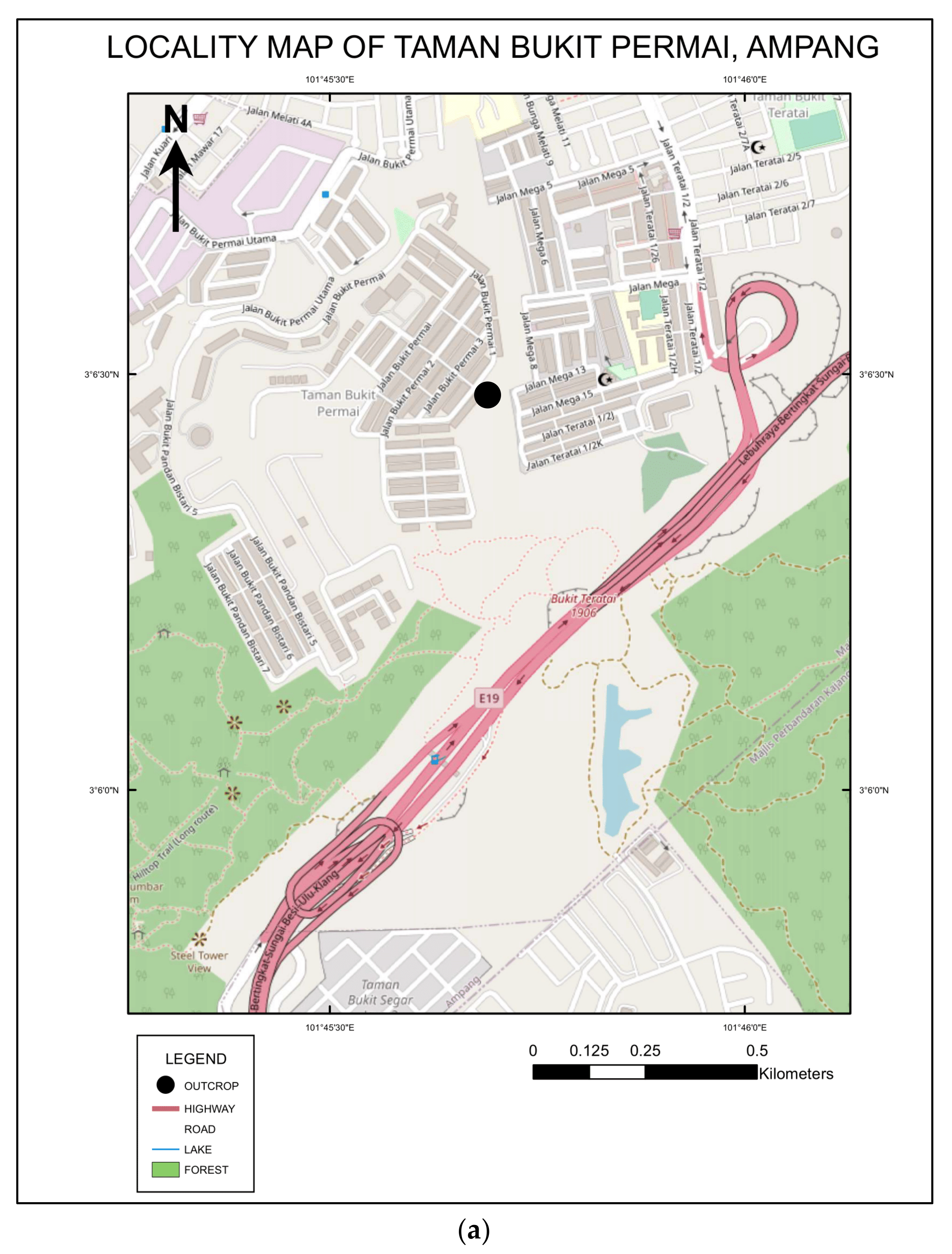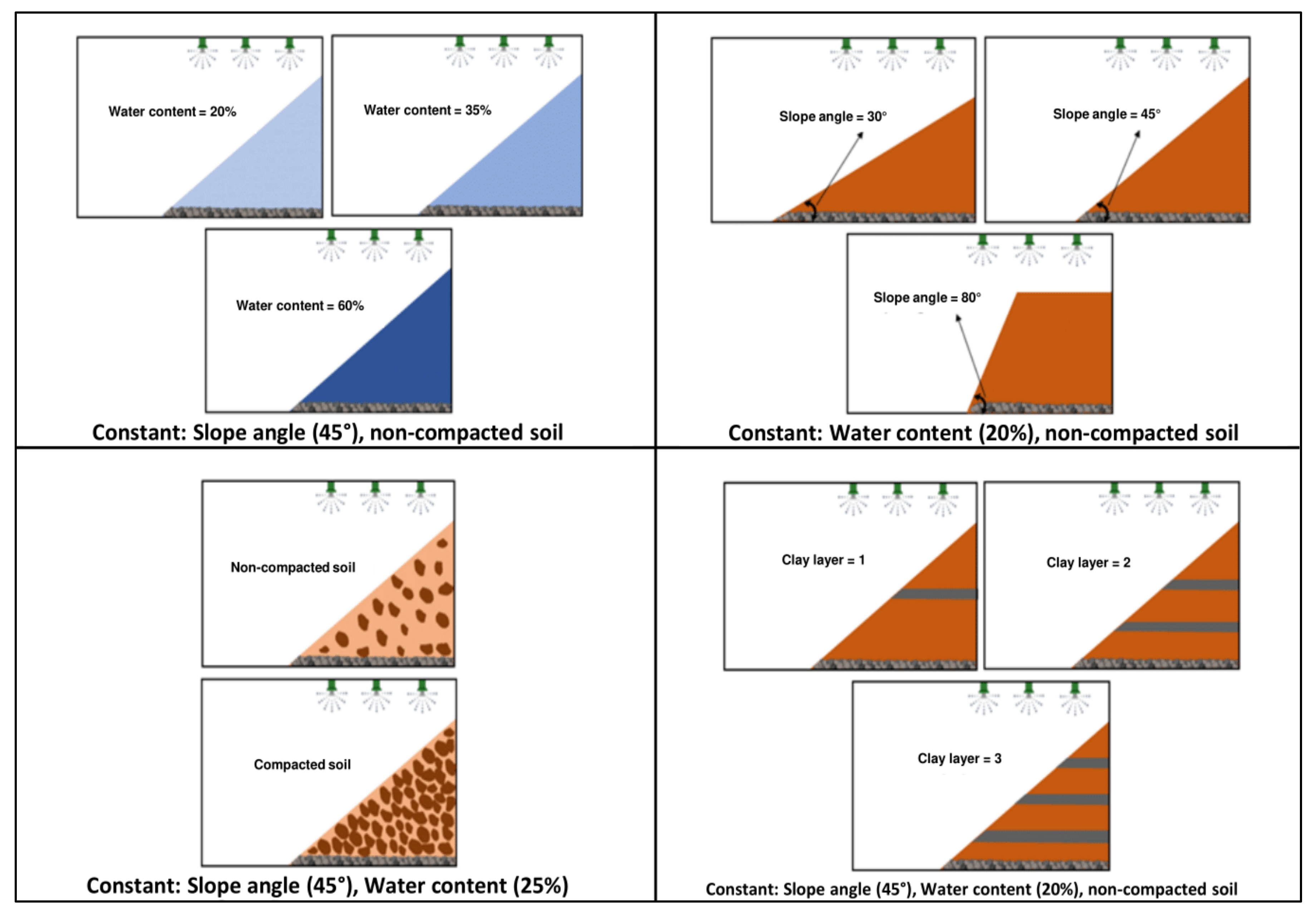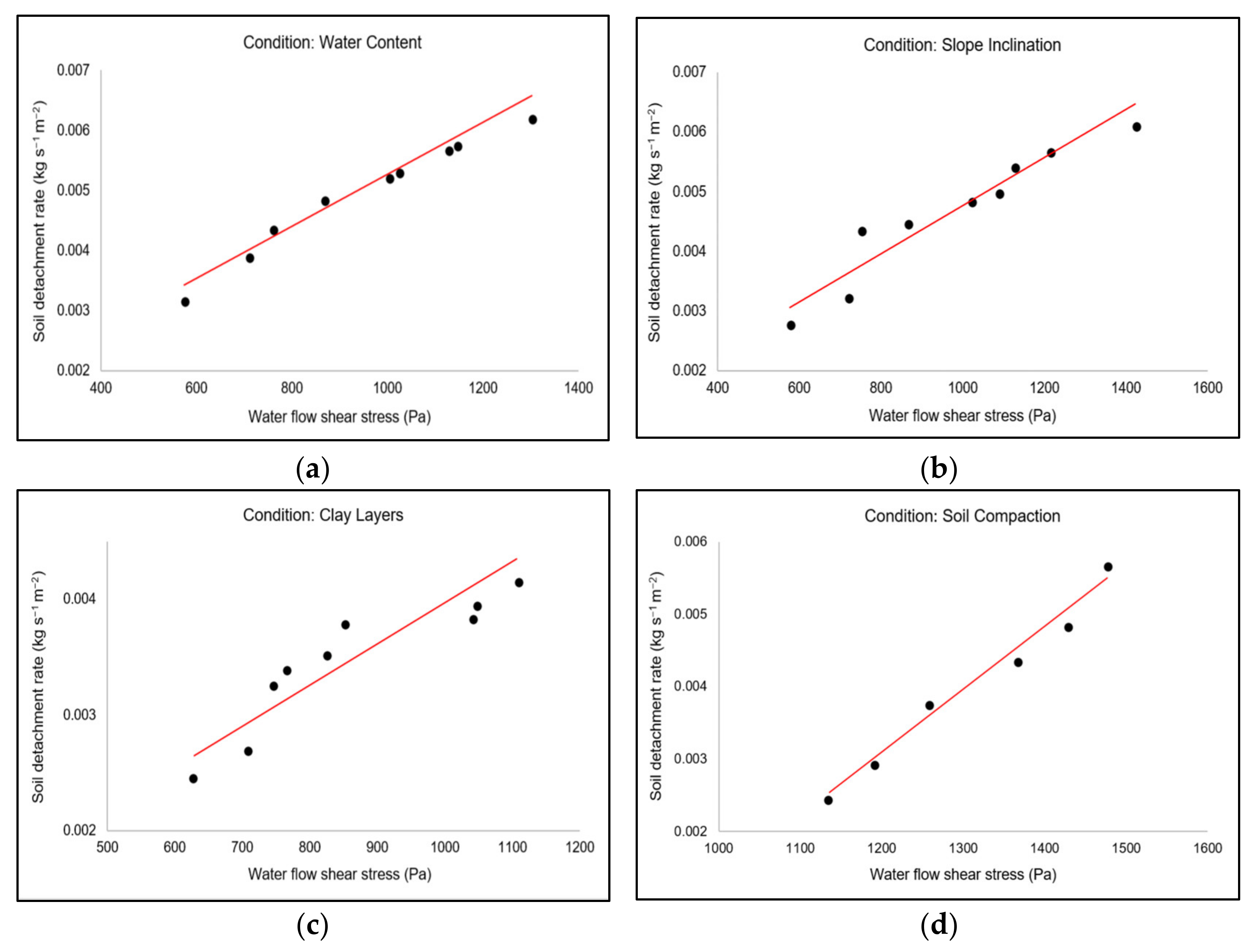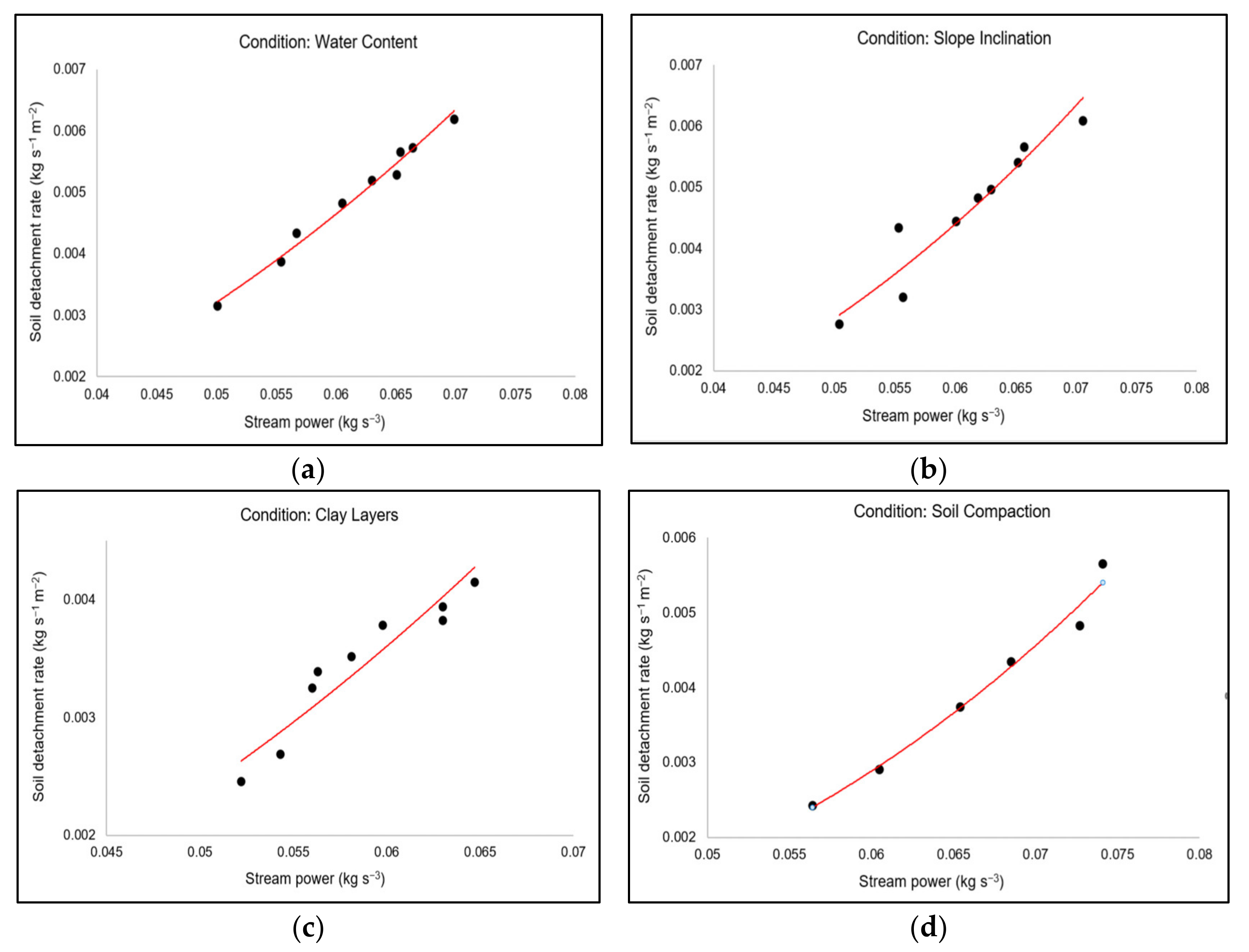Soil Detachment Rate of a Rainfall-Induced Landslide Soil
Abstract
1. Introduction
2. Materials and Methods
2.1. Study Area
2.2. Soil Sampling and Preparation
2.3. Experimental Setup
2.4. Rainfall Simulator
2.5. Simulation Conditions
2.6. Soil Detachment Rate, Hydraulic Parameters, and Data Calculation
- M (kg) is the dry weight of the soil loss;
- t (s) is the duration of rainfall;
- b (m) is the mean water flow width during the rainfall time;
- L (m) is the total flow distance of water that can transport sediment.
- ρ (kgm−3) is the density of water;
- g (ms−2) is the gravity acceleration;
- R (m) is the hydraulic radius of the slope;
- J (mm−1) is the slope gradient.
- a (m) is the mean water flow length of the slope during the rainfall time;
- b (m) is the mean water flow width of the slope during the rainfall time.
- τ (Pa) is water flow shear stress;
- V (ms−1) is the average flow velocity.
2.7. Statistical Analysis
3. Results and Discussion
3.1. Physicochemical Properties of Soil
3.2. The Effect of Various Soil Conditions on Soil Detachment Rate
3.3. The Relationship between Rainfall Intensities, Hydraulic Parameters, Soil Conditions and Soil Detachment Rate
4. Conclusions
Author Contributions
Funding
Data Availability Statement
Conflicts of Interest
References
- Consoli, N.C.; Foppa, D.; Festugato, L.; Heineck, K.S. Key Parameters for Strength Control of Artificially Cemented Soils. J. Geotech. Geoenviron. Eng. 2007, 133, 197–205. [Google Scholar] [CrossRef]
- Liu, Y.; Deng, Z.; Wang, X. The Effects of Rainfall, Soil Type and Slope on the Processes and Mechanisms of Rainfall-Induced Shallow Landslides. Appl. Sci. 2021, 11, 11652. [Google Scholar] [CrossRef]
- Yalcin, A. The Effects of Clay on Landslides: A Case Study. Appl. Clay Sci. 2007, 38, 77–85. [Google Scholar]
- Dai, F.C.; Lee, C.F.; Li, J.; Xu, Z.W. Assessment of Landslide Susceptibility on the Natural Terrain of Lantau Island, Hong Kong. Environ. Geol. 2001, 40, 381–391. [Google Scholar]
- Rosso, R.; Rulli, M.C.; Vannucchi, G. A Physically Based Model for the Hydrologic Control on Shallow Landsliding. Water Resour. Res. 2006, 42, W06410. [Google Scholar] [CrossRef]
- Mahmood, K.; Kim, J.M.; Ashraf, M.; Ziaurrehman. The Effect of Soil Type on Matric Suction and Stability of Unsaturated Slope under Uniform Rainfall. KSCE J. Civ. Eng. 2016, 20, 1294–1299. [Google Scholar] [CrossRef]
- Akter, A.; Noor, M.J.M.M.; Goto, M.; Khanam, S.; Parvez, A.; Rasheduzzaman, M. Landslide Disaster in Malaysia: An Overview. Int. J. Innov. Res. Dev. 2019, 8, 58–71. [Google Scholar] [CrossRef]
- Majid, N.A. Historical Landslide Events in Malaysia 1993–2019. Indian J. Sci. Technol. 2020, 13, 3387–3399. [Google Scholar] [CrossRef]
- Rosly, M.H.; Mohamad, H.M.; Bolong, N.; Harith, N.S.H. An Overview: Relationship of Geological Condition and Rainfall with Landslide Events at East Malaysia. Trends Sci. 2022, 19, 3464. [Google Scholar] [CrossRef]
- van Beek, R.; Cammeraat, E.; Andreu, V.; Mickovski, S.B.; Dorren, L. Hillslope processes: Mass wasting, slope stability and erosion. In Slope Stability and Erosion Control: Ecotechnological Solutions; Springer: Dordrecht, The Netherlands, 2008; pp. 17–64. [Google Scholar]
- Zhang, G.; Liu, B.; Liu, G.; He, X.; Nearing, M.A. Detachment of Undisturbed Soil by Shallow Flow. Soil Sci. Soc. Am. J. 2003, 67, 713–719. [Google Scholar] [CrossRef]
- Holz, D.J.; Williard, K.W.J.; Edwards, P.J.; Schoonover, J.E. Soil Erosion in Humid Regions: A Review. J. Contemp. Water Res. Educ. 2015, 154, 48–59. [Google Scholar] [CrossRef]
- Gan, F.; He, B.; Qin, Z. Research on Soil Detachment Rate and Hydrodynamic Parameters of Dip/Anti-Dip Slope in Simulated Karst Trough Valley. Environ. Earth Sci. 2019, 78, 617. [Google Scholar] [CrossRef]
- Zhang, G.; Liu, Y.; Han, Y.; Zhang, X.C. Sediment Transport and Soil Detachment on Steep Slopes: I. Transport Capacity Estimation. Soil Sci. Soc. Am. J. 2009, 73, 1291–1297. [Google Scholar] [CrossRef]
- Wang, Y.; Cao, L.; Fan, J.; Lu, H.; Zhu, Y.; Gu, Y.; Sun, B.; Liang, Y. Modelling Soil Detachment of Different Management Practices in the Red Soil Region of China. L. Degrad. Dev. 2017, 28, 1496–1505. [Google Scholar] [CrossRef]
- Shen, N.; Wang, Z.; Zhang, Q.; Wu, B.; Liu, J. Modelling the Process of Soil Detachment by Rill Flow on Steep Loessial Hillslopes. Earth Surf. Process. Landf. 2020, 45, 1240–1247. [Google Scholar] [CrossRef]
- Zhu, X.; Fu, S.; Wu, Q.; Wang, A. Soil Detachment Capacity of Shallow Overland Flow in Earth-Rocky Mountain Area of Southwest China. Geoderma 2020, 361, 114021. [Google Scholar] [CrossRef]
- Zhang, G.H.; Bin Liu, G.; Tang, K.M.; Zhang, X.C.J. Flow Detachment of Soils under Different Land Uses in the Loess Plateau of China. Trans. ASABE 2008, 51, 883–890. [Google Scholar] [CrossRef]
- Yan, Y.; Dai, Q.; Yuan, Y.; Peng, X.; Zhao, L.; Yang, J. Effects of Rainfall Intensity on Runoff and Sediment Yields on Bare Slopes in a Karst Area, SW China. Geoderma 2018, 330, 30–40. [Google Scholar] [CrossRef]
- Novara, A.; Gristina, L.; Saladino, S.S.; Santoro, A.; Cerdà, A. Soil Erosion Assessment on Tillage and Alternative Soil Managements in a Sicilian Vineyard. Soil Tillage Res. 2011, 117, 140–147. [Google Scholar] [CrossRef]
- Wang, J.; Feng, S.; Ni, S.; Wen, H.; Cai, C.; Guo, Z. Soil Detachment by Overland Flow on Hillslopes with Permanent Gullies in the Granite Area of Southeast China. Catena 2019, 183, 104235. [Google Scholar] [CrossRef]
- McClay, K.R. Deformation Mechanics in Analogue Models of Extensional Fault Systems. Geol. Soc. Spec. Publ. 1990, 54, 445–453. [Google Scholar] [CrossRef]
- Bignell, J.D.; Snelling, N.J. K-Ar Ages on Some Basic Igneous Rocks from Peninsular Malaysia and Thailand. Bull. Geol. Soc. Malays. 1977, 8, 89–93. [Google Scholar] [CrossRef]
- Parhizkar, M.; Shabanpour, M.; Khaledian, M.; Cerdà, A.; Rose, C.W.; Asadi, H.; Lucas-Borja, M.E.; Zema, D.A. Assessing and Modeling Soil Detachment Capacity by Overland Flow in Forest and Woodland of Northern Iran. Forests 2020, 11, 65. [Google Scholar] [CrossRef]
- Wang, J. Theory of Flow Distribution in Manifolds. Chem. Eng. J. 2011, 168, 1331–1345. [Google Scholar] [CrossRef]
- ASTM D698-12; Standard Test Methods for Laboratory Compaction Characteristics of Soil Using Standard Effort (12 400 ft-lbf/ft3 (600 kN-m/m3)). ASTM International: West Conshohocken, PA, USA, 2014.
- ASTM D2216-19; Standard Test Methods for Laboratory Determination of Water (Moisture) Content of Soil and Rock by Mass. ASTM International: West Conshohocken, PA, USA, 2019.
- ASTM D854-00; Standard Test Methods for Specific Gravity of Soil Solids by Water Pycnometer. ASTM International: West Conshohocken, PA, USA, 2017.
- ASTM D6913-04(2009)e1; Standard Test Methods for Particle-Size Distribution (Gradation) of Soils Using Sieve Analysis. ASTM International: West Conshohocken, PA, USA, 2017.
- ASTM D7928-21e1; Standard Test Method for Particle-Size Distribution (Gradation) of Fine-Grained Soils Using the Sedimentation (Hydrometer) Analysis. ASTM International: West Conshohocken, PA, USA, 2021.
- ASTM D4318-17; Standard Test Methods for Liquid Limit, Plastic Limit, and Plasticity Index of Soils. ASTM International: West Conshohocken, PA, USA, 2018.
- ASTM D4221-18; Standard Test Method for Dispersive Characteristics of Clay Soil by Double Hydrometers. ASTM International: West Conshohocken, PA, USA, 2018.
- Cresswell, H.P.; Smiles, D.E.; Williams, J. Soil Structure, Soil Hydraulic Properties and the Soil Water Balance. Aust. J. Soil Res. 1992, 30, 265–283. [Google Scholar] [CrossRef]
- Hino, M.; Odaka, Y.; Nadaoka, K.; Sato, A. Effect of Initial Soil Moisture Content on the Vertical Infiltration Process—A Guide to the Problem of Runoff-Ratio and Loss. J. Hydrol. 1988, 102, 267–284. [Google Scholar] [CrossRef]
- Bernatek-Jakiel, A.; Bruthans, J.; Vojtíšek, J.; Stolarczyk, M.; Zaleski, T. Sediment Detachment in Piping-Prone Soils: Cohesion Sources and Potential Weakening Mechanisms. Earth Surf. Process. Landf. 2020, 45, 3185–3201. [Google Scholar] [CrossRef]
- Jing, X.; Chen, Y.; Pan, C.; Yin, T.; Wang, W.; Fan, X. Erosion Failure of a Soil Slope by Heavy Rain: Laboratory Investigation and Modified GA Model of Soil Slope Failure. Int. J. Environ. Res. Public Health 2019, 16, 1075. [Google Scholar] [CrossRef]
- Savage, W.; Baum, R. Instability of steep slopes. In Debris-Flow Hazards and Related Phenomena; Springer: Berlin/Heidelberg, Germany, 2007; pp. 53–79. [Google Scholar]
- Rieke-Zapp, D.H.; Nearing, M.A. Digital Close-Range Photogrammetry for Measurement of Soil Erosion. Photogramm. Rec. 2005, 20, 69–87. [Google Scholar] [CrossRef]
- Su, Z.L.; Zhang, G.H.; Yi, T.; Liu, F. Soil Detachment Capacity by Overland Flow for Soils of the Beijing Region. Soil Sci. 2014, 179, 446–453. [Google Scholar] [CrossRef]
- Knapen, A.; Poesen, J.; Govers, G.; Gyssels, G.; Nachtergaele, J. Resistance of Soils to Concentrated Flow Erosion: A Review. Earth-Sci. Rev. 2007, 80, 75–109. [Google Scholar] [CrossRef]
- Zhang, B.; Zhao, Q.G.; Horn, R.; Baumgartl, T. Shear Strength of Surface Soil as Affected by Soil Bulk Density and Soil Water Content. Soil Tillage Res. 2001, 59, 97–106. [Google Scholar] [CrossRef]
- Li, Z.W.; Zhang, G.H.; Geng, R.; Wang, H.; Zhang, X.C. Land Use Impacts on Soil Detachment Capacity by Overland Flow in the Loess Plateau, China. Catena 2015, 124, 9–17. [Google Scholar] [CrossRef]
- Giménez, R.; Govers, G. Flow Detachment by Concentrated Flow on Smooth and Irregular Beds. Soil Sci. Soc. Am. J. 2002, 66, 1475–1483. [Google Scholar] [CrossRef]
- Gilley, J.E.; Finkner, S.C. Estimating Soil Detachment Caused by Raindrop Impact. Trans. Am. Soc. Agric. Eng. 1985, 28, 140–146. [Google Scholar] [CrossRef]
- Youno, R.A.; Wiersma, J.L. The role of rainfall impact in soil detachment and transport. Water Resour. Res. 1973, 9, 1629–1636. [Google Scholar]









| Features | Number |
|---|---|
| Landslide area | 8671 m2 |
| Landslide length | 178.96 m |
| Landslide width | 74.98 m |
| Landslide depth | 3 m |
| Landslide volume | ≈26,013 m3 |
| Houses affected | 16 |
| Type of landslide | Complex (Rotational, translational, flow) |
| Soil Characteristics | Standard | Results |
|---|---|---|
| Bulk Density (g/cm3) | ASTM D698-12 [26] | 1.71 |
| Moisture Content (%) | ASTM D2216-19 [27] | 34.54 |
| Specific Gravity | ASTM D854-00 [28] | 2.57 |
| Gravel (%) | ASTM D6913-04(2009)e1 [29] | 7.4 |
| Sand (%) | ASTM D6913-04(2009)e1 [29] | 42.6 |
| Silt (%) | ASTM D7928-21e1 [30] | 36.8 |
| Clay (%) | ASTM D7928-21e1 [30] | 13.2 |
| Liquid Limit (%) | ASTM D4318-17 [31] | 61.2 |
| Plastic limit (%) | ASTM D4318-17 [31] | 36.4 |
| Plasticity index (%) | ASTM D4318-17 [31] | 24.8 |
| Mineral content | Quartz, muscovite, halloysite | |
| Optimum moisture content (%) | ASTM D698-12 [26] | 25.8 |
| Maximum dry density (g/cm3) | ASTM D698-12 [26] | 1.49 |
| Dispersion | ASTM D4221-18 [32] | Non-dispersive |
| Bulk Density [g/cm3] | Rainfall Intensity [mm/h] | Soil Detachment Rate [kg s−1 m−2] |
|---|---|---|
| 1.7 [Compacted soil] | 16 | 0.002426069 |
| 42 | 0.002908041 | |
| 105 | 0.003734985 | |
| 1.3 [Non-compacted soil] | 16 | 0.004337559 |
| 42 | 0.004821022 | |
| 105 | 0.005652258 |
| Conditions | Sub-Conditions | Rainfall Intensity [mm/h] | Water Flow Shear Stress [Pa] | Critical Flow Shear Stress [Pa] | Stream Power [kg s−3] | Soil Detachment Rate [kg s−1 m−2] |
|---|---|---|---|---|---|---|
| Water content | Water content = 20% | Low | 576.785 | 96.67 | 0.0501 | 0.003146806 |
| Medium | 711.699 | 0.0554 | 0.003871489 | |||
| High | 1025.536 | 0.0651 | 0.005283061 | |||
| Water content = 35% | Low | 761.988 | 0.0567 | 0.004337559 | ||
| Medium | 870.213 | 0.0605 | 0.004821022 | |||
| High | 1129.539 | 0.0654 | 0.005652258 | |||
| Water content = 60% | Low | 1005.441 | 0.0630 | 0.005192218 | ||
| Medium | 1147.563 | 0.0664 | 0.005726852 | |||
| High | 1303.907 | 0.0699 | 0.006181125 | |||
| Slope inclination | Slope angle = 30° | Low | 579.774 | 0.0504 | 0.002759622 | |
| Medium | 721.696 | 0.0557 | 0.003204103 | |||
| High | 868.224 | 0.0601 | 0.004445713 | |||
| Slope angle = 45° | Low | 753.654 | 0.0553 | 0.004337559 | ||
| Medium | 1023.572 | 86 | 0.0619 | 0.004821022 | ||
| High | 1217.241 | 0.0657 | 0.005652258 | |||
| Slope angle = 80° | Low | 1091.432 | 0.0630 | 0.004963666 | ||
| Medium | 1128.566 | 0.0652 | 0.005402778 | |||
| High | 1425.330 | 0.0706 | 0.006089983 | |||
| Clay layers | 1 | Low | 746.789 | 0.0560 | 0.003250472 | |
| Medium | 1042.024 | 0.0630 | 0.003825571 | |||
| High | 1110.072 | 0.0647 | 0.004146902 | |||
| 2 | Low | 708.905 | 0.0543 | 0.002687259 | ||
| Medium | 825.976 | 112 | 0.0581 | 0.003516104 | ||
| High | 1048.768 | 0.0630 | 0.003939352 | |||
| 3 | Low | 627.490 | 0.0522 | 0.002454321 | ||
| Medium | 766.651 | 0.0563 | 0.003388499 | |||
| High | 853.062 | 0.0598 | 0.003783151 | |||
| Soil compaction | Compacted soil | Low | 1134.657 | 865.56 | 0.0564 | 0.002426069 |
| Medium | 1191.610 | 0.0605 | 0.002908041 | |||
| High | 1258.497 | 0.0654 | 0.003734985 | |||
| Non-compacted soil | Low | 1367.358 | 0.0685 | 0.004337559 | ||
| Medium | 1429.251 | 0.0727 | 0.004821022 | |||
| High | 1478.153 | 0.0741 | 0.005652258 |
| Condition | Regression Equation | Correlation Coefficient, r | Coefficient of Determination, R2 | Significance Level, p |
|---|---|---|---|---|
| Water content | 0.989 | 0.976 | 0.0000001 | |
| Slope inclination | 0.921 | 0.984 | 0.00004 | |
| Clay layers | 0.915 | 0.837 | 0.00055 | |
| Soil compaction | 0.990 | 0.981 | 0.00014 |
| Condition | Regression Equation | Correlation Coefficient, r | Coefficient of Determination, R2 | Significance Level, p |
|---|---|---|---|---|
| Water content | 0.992 | 0.984 | 0.0000001 | |
| Slope inclination | 0.967 | 0.934 | 0.00002 | |
| Clay layers | 0.939 | 0.881 | 0.00018 | |
| Soil compaction | 0.994 | 0.988 | 0.00005 |
| Soil Detachment Rate | Water Content | Slope Inclination | Clay Layers | Soil Compaction | Water Flow Shear Stress | Stream Power | |
|---|---|---|---|---|---|---|---|
| Soil detachment rate | 1.000 | 0.487 | 0.429 | −0.452 | −0.357 | 0.634 | 0.821 |
| Water content | 0.487 | 1.000 | −0.083 | −0.289 | −0.027 | 0.311 | 0.389 |
| Slope inclination | 0.429 | −0.083 | 1.000 | −0.099 | −0.056 | 0.470 | 0.444 |
| Clay layers | −0.452 | −0.289 | −0.099 | 1.000 | −0.196 | −0.346 | −0.285 |
| Soil compaction | −0.357 | −0.027 | −0.056 | −0.196 | 1.000 | 0.354 | 0.027 |
| Water flow shear stress | 0.634 | 0.311 | 0.470 | −0.346 | 0.354 | 1.000 | 0.919 |
| Stream power | 0.821 | 0.389 | 0.444 | −0.285 | 0.027 | 0.919 | 1.000 |
Disclaimer/Publisher’s Note: The statements, opinions and data contained in all publications are solely those of the individual author(s) and contributor(s) and not of MDPI and/or the editor(s). MDPI and/or the editor(s) disclaim responsibility for any injury to people or property resulting from any ideas, methods, instructions or products referred to in the content. |
© 2023 by the authors. Licensee MDPI, Basel, Switzerland. This article is an open access article distributed under the terms and conditions of the Creative Commons Attribution (CC BY) license (https://creativecommons.org/licenses/by/4.0/).
Share and Cite
Batumalai, P.; Mohd Nazer, N.S.; Simon, N.; Sulaiman, N.; Umor, M.R.; Ghazali, M.A. Soil Detachment Rate of a Rainfall-Induced Landslide Soil. Water 2023, 15, 2149. https://doi.org/10.3390/w15122149
Batumalai P, Mohd Nazer NS, Simon N, Sulaiman N, Umor MR, Ghazali MA. Soil Detachment Rate of a Rainfall-Induced Landslide Soil. Water. 2023; 15(12):2149. https://doi.org/10.3390/w15122149
Chicago/Turabian StyleBatumalai, Pavithran, Nor Shahidah Mohd Nazer, Norbert Simon, Norasiah Sulaiman, Mohd Rozi Umor, and Mohamad Anuri Ghazali. 2023. "Soil Detachment Rate of a Rainfall-Induced Landslide Soil" Water 15, no. 12: 2149. https://doi.org/10.3390/w15122149
APA StyleBatumalai, P., Mohd Nazer, N. S., Simon, N., Sulaiman, N., Umor, M. R., & Ghazali, M. A. (2023). Soil Detachment Rate of a Rainfall-Induced Landslide Soil. Water, 15(12), 2149. https://doi.org/10.3390/w15122149






